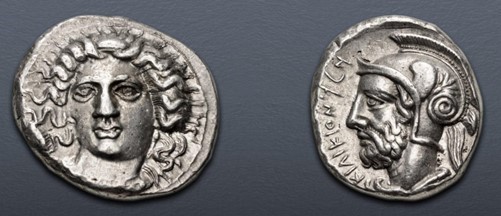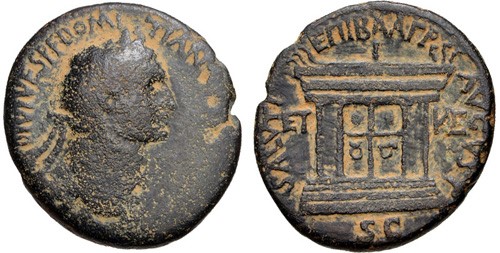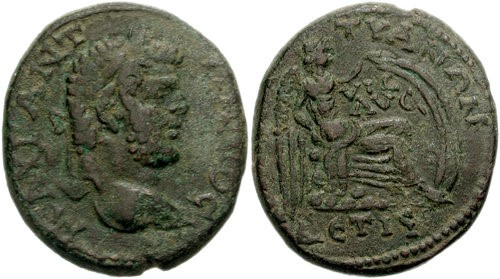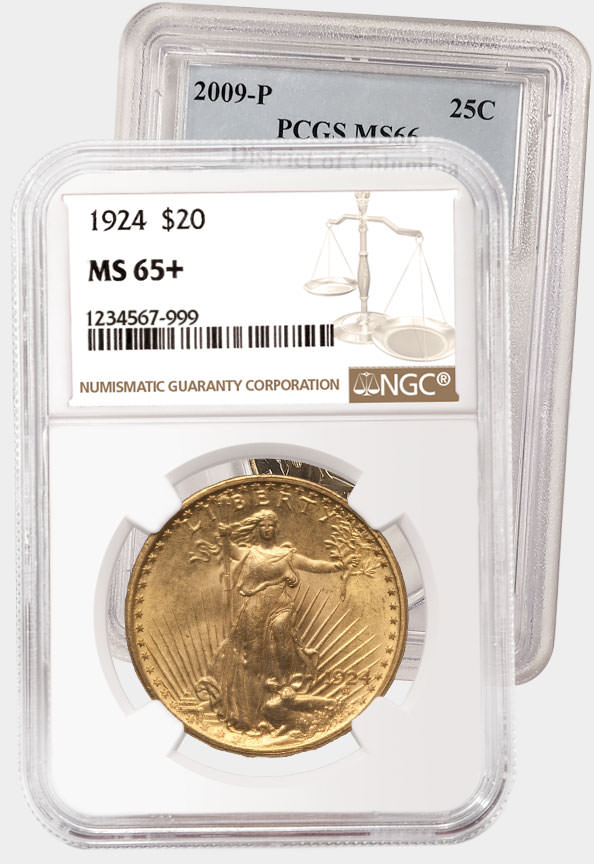NGC Ancients: Bilingual Coins of the Ancient World
Posted on 2/14/2023
By
Ben Wallace
NGC Ancients Grader
Many languages were spoken in the ancient world. However, just like today, some languages were more important than others in facilitating trade and communication between different cultures. Greek and Latin were two of the most important languages in the ancient Western world.
Surprisingly, with how much trade and movement that occurred, the number of "bilingual" coins is relatively small. While we don’t have any firsthand evidence about why some rulers made coins with multiple languages and others didn’t, we can make some inferences.
 |
An excellent place to begin our survey of bilingual coins is a silver stater of the Persian Satrap Pharnabazus (c.380 to 374/3 B.C.), struck at the city of Tarsus (in modern day Turkey). The obverse shows a facing female head. The reverse has a helmeted bust, perhaps of the god Ares. Before his profile is the Greek inscription “KIΛIKION” followed by the Aramaic letters “HLK.”
The expansion of Hellenistic culture into the East through the conquests of the Greek king Alexander III “the Great” (336 to 323 B.C.) led to the spread of Greek language and civilization. This influence continued long after Alexander’s death. The next three coins all are from a region that came under the influence of Greek conquerors.
 |
Coins of the Kingdom of Bactria often are bilingual, including this silver square drachm of King Agathocles (185 to 180/70 B.C.). The obverse shows the Indian god Balarama-Samkarshana holding a mace and a plow, flanked by the Greek inscription “[coin] of King Agathocles.” The reverse has the Indian god Vasudeva-Krishna, who holds a sankha, a shell with religious symbolism, and a chakra wheel. The reverse inscription mirrors the Greek, but in the local script Karosthi.
 |
Made about a generation after the previous coin, this tetradrachm of the Indo-Greek king Menander (c.165/55 to 130 B.C.) shows the heroic portrait of the king on the obverse. The reverse shows the goddess Athena advancing, brandishing a lightning bolt. Both the Greek and Karosthi legends read along the lines “[coin] of King Menander, the savior.”
 |
Rounding out the bilingual coinage of the Indo-Greek Kingdom is this tetradrachm made under King Artemidorus (c.100 to 80 B.C.). A stern portrait of the king is shown on the obverse. The Greek goddess Artemis draws her bow on the reverse. Both the Greek and Karosthi legends read along the lines, “[coin] of the invincible king Artemidorus.”
 |
Jumping all the way from the border of India to the western shores of North Africa, we continue our survey with this interesting silver denarius of the Mauretanian king Juba II (25 B.C. to A.D. 23/4). The obverse shows Juba II with the Latin legend “King Juba.” The reverse shows Cleopatra Selene II, with her Greek legend “[coin] of Queen Cleopatra.”
Juba had strong ties with Rome and was its stalwart ally, presumably the reason his legend is Latin. Since Cleopatra Selene II was the latest in the long line of Greek rulers of Egypt (the Ptolemies), she used a Greek legend.
The two languages on this coin pull from the personal histories of each ruler. Juba II was captured by the Romans after his father lost his kingdom to Julius Caesar. He was taken to Rome and educated, going so far as to become a Roman citizen! Rome’s first emperor, Augustus (27 B.C. to A.D. 14), eventually restored him to his father's throne.
Once in power, Juba ruled alongside his wife and queen, Cleopatra Selene II, daughter of the late queen of Egypt, Cleopatra VII, and her Roman husband and ally, Marc Antony.
 |
Moving our survey into the Roman Empire, we find this 37mm bronze of the emperor Domitian (A.D. 81 to 96). Made in the provincial city of Philippopolis in Southeast Europe, this coin also has both Latin and Greek legends. The obverse shows the emperor with his many titles in Latin. The reverse has a scene of the goddess Tyche of Philippopolis standing by the reclining river-god Hebrus, flanked by a Greek inscription dedicated to the city.
The Romans didn’t force their Latin language on people they conquered. Most eastern cities of the empire continued to use Greek as their daily language (which appeared on their local coinage). The reason they used both languages on this piece are unknown.
 |
The 25mm bronze above was also minted for the emperor Domitian, but by the Judaean client king Agrippa II (A.D. 49 to 95). The obverse has the bust of the emperor surrounded by a Latin legend naming him and his titles. The reverse has a square altar with a Greek legend dedicated to King Agrippa II.
 |
Made at the city of Tyana, in modern day Turkey, this 25mm bronze shows the bust of the Roman emperor Caracalla (A.D. 198 to 217) with most of its inscription in Greek. The reverse has Victory seated, holding a shield, bearing the small Latin inscription “VIC AVG.”
 |
Rounding out our column on bilingual ancient coins is the 32mm bronze shown above. It was made for the emperor Severus Alexander (A.D. 222 to 235) at the city of Abydus, located in modern day Turkey. The obverse shows the bust of the emperor surrounded by a Latin legend. The reverse has the name of the city in Greek surrounding a famous mythological story from the region. The god of love, Eros, flies above a scene where Leander swims across the sea to reach his lover, the priestess Hero, who stands in a tower using her lamp to light his way.
Images courtesy of Classical Numismatic Group and Heritage Auctions.
Interested in reading more articles on Ancient coins? Click here.
Stay Informed
Want news like this delivered to your inbox once a month? Subscribe to the free NGC eNewsletter today!
